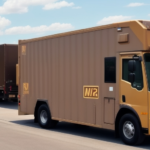Introduction to Shipping Methods
When it comes to shipping, selecting the right method is crucial for ensuring timely delivery, cost-effectiveness, and the safety of your packages. Two of the most common shipping methods are standard shipping and ground shipping. While these methods share similarities, they also present distinct differences that can significantly impact your shipping decisions. This article delves into the intricacies of both standard and ground shipping, providing you with the insights needed to choose the best option for your specific needs.
Standard Shipping
What is Standard Shipping?
Standard shipping refers to the conventional method of delivering packages through national postal services or private carriers. Typically, this method takes 2-8 business days, with delivery times varying based on the distance and the carrier's logistics. Standard shipping is generally more cost-effective compared to expedited options like express or overnight shipping.[1]
How Does Standard Shipping Work?
Standard shipping is managed by national postal services such as the United States Postal Service (USPS), or private carriers like FedEx and UPS. The process begins with the shipper dropping off the package at a designated location, such as a post office or a shipping center. The package is then processed and dispatched for delivery, which may involve transportation by air or ground. Upon arrival at the destination hub, the package is sorted and delivered to the recipient's address. It's important to note that standard shipping typically excludes additional services like signature confirmation or insurance unless specifically requested and paid for.
Pros and Cons of Standard Shipping
Advantages:
- Affordability: Standard shipping is usually the most budget-friendly option.
- Convenience: Packages are delivered directly to the recipient's doorstep.
- Environmental Benefits: Efficient routing can reduce the overall carbon footprint.
Disadvantages:
- Longer Delivery Times: Can be a drawback for time-sensitive deliveries.
- Limited Tracking: Some carriers may offer minimal tracking information.
Ground Shipping
What is Ground Shipping?
Ground shipping involves the transportation of packages via land-based networks, such as trucks or trains. This method typically takes 1-7 business days, depending on the shipment's distance and the carrier's infrastructure. Ground shipping is ideal for larger or heavier packages that are not time-critical.[2]
How Does Ground Shipping Work?
Ground shipping is facilitated by transportation networks that utilize ground vehicles like trucks or trains. Shippers deposit their packages at designated drop-off points, where they are loaded onto transportation vehicles for delivery. The packages traverse various transit points before reaching their final destination, where they are handled by local couriers for last-mile delivery. Ground shipping is often preferred for its cost-effectiveness and reliability, especially for bulky or heavy items.
Pros and Cons of Ground Shipping
Advantages:
- Cost-Effective: Generally cheaper than air or expedited shipping methods.
- Environmentally Friendly: Lower emissions compared to air transportation.
- Reliability: Less susceptible to weather-related delays.
Disadvantages:
- Longer Transit Times: Not suitable for urgent deliveries.
- Limited Geographical Reach: May not be available in remote areas.
Comparing Standard and Ground Shipping
Price Comparison
Both standard and ground shipping are typically more affordable than expedited shipping options. However, pricing can vary based on factors such as package weight, dimensions, and delivery distance. Generally, ground shipping may be slightly more expensive than standard shipping, but this difference can be offset when shipping oversized or heavy items that would incur higher costs with standard methods.[3]
Speed Comparison
Standard shipping usually delivers packages within 2-8 business days, making it slightly faster than ground shipping, which takes about 1-7 business days. However, the difference in delivery times may not be significant enough to justify the additional cost of standard shipping, especially when considering the nature and urgency of the shipment.[4]
Choosing the Right Shipping Method for Your Needs
Factors to Consider
When deciding between standard and ground shipping, consider the following factors:
- Cost: Assess your budget and choose the most economical option that meets your needs.
- Delivery Time: Determine how quickly the package needs to arrive.
- Package Size and Weight: Larger and heavier packages are better suited for ground shipping.
- Tracking and Additional Services: Decide if you need features like tracking, insurance, or signature confirmation.
- Environmental Impact: Consider the carbon footprint of your shipping choice.
Saving on Shipping Costs
To reduce shipping expenses, consider the following strategies:
- Volume Discounts: Negotiate rates with carriers if you ship in large quantities.
- Optimize Packaging: Use appropriately sized boxes to minimize excess weight and space.
- Choose the Right Carrier: Some carriers offer discounted rates based on package size or shipping destinations.
Best Practices for Preparing Packages
Proper package preparation ensures the safety and efficiency of your shipments:
- Use Sturdy Materials: Ensure boxes and packing materials can withstand handling and transit.
- Clear Labeling: Include accurate and legible addresses, and consider using barcodes for tracking.
- Follow Carrier Guidelines: Adhere to specific shipping requirements, especially for hazardous or fragile items.
Tracking Your Shipments
Package tracking provides visibility into the status and location of your shipments. Both standard and ground shipping methods typically offer tracking services, though the extent of tracking information may vary by carrier. Utilize the carrier's tracking tools to monitor your package's progress and anticipate its arrival.[5]
Shipping Heavy or Oversized Items
Shipping bulky or heavy items requires special considerations:
- Disassemble Large Items: Break down items into smaller components to reduce size and weight.
- Choose Specialized Carriers: Some carriers specialize in oversized shipments and can handle the logistics more effectively.
- Secure Packaging: Ensure that heavy items are well-protected to prevent damage during transit.
Conclusion
Choosing between standard and ground shipping depends on various factors, including cost, delivery speed, package size, and specific shipping needs. By thoroughly evaluating these aspects and understanding the strengths and limitations of each method, you can make informed decisions that align with your personal or business shipping requirements. Implementing best practices in packaging and leveraging cost-saving strategies can further enhance the efficiency and affordability of your shipping processes.
For more detailed information on shipping options and best practices, you can refer to reputable sources such as the United States Postal Service, FedEx, and UPS.






















